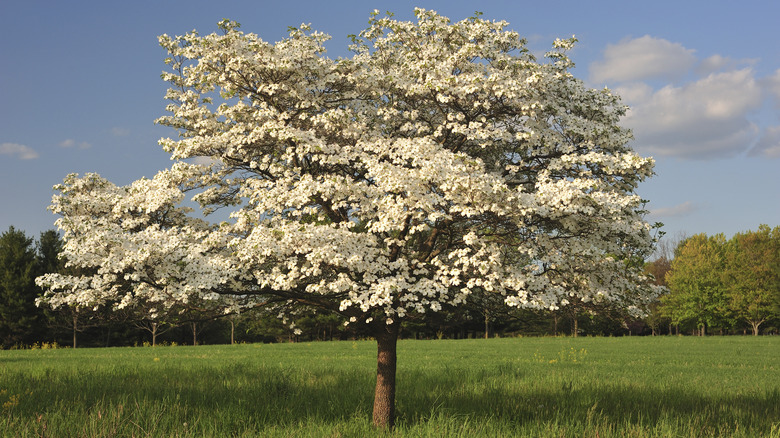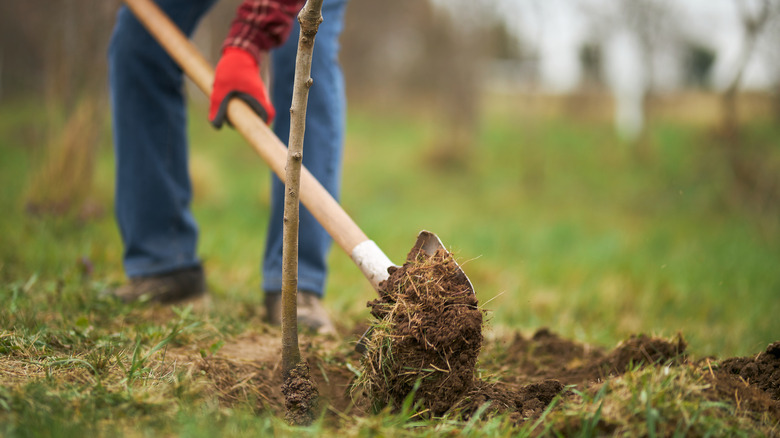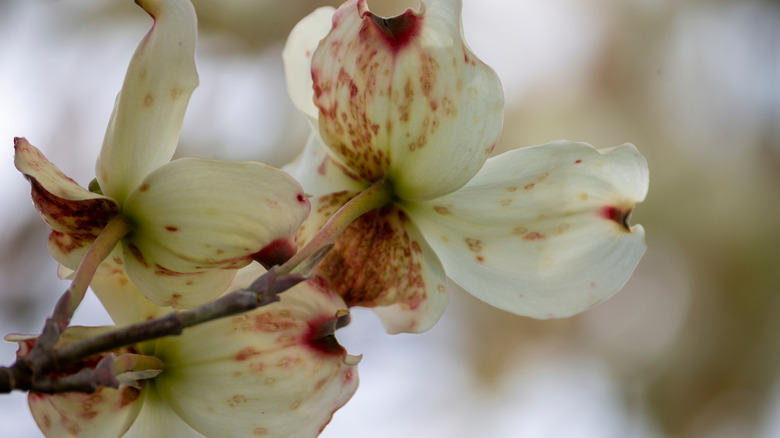The Hidden Downside To Planting A Dogwood Tree In Your Yard
If you're planning to plant a dogwood tree in your yard, understanding its growth characteristics and care requirements is essential. Known for their stunning blossoms and versatility, the tree originates from diverse regions like North America, Asia, and Europe.
However, dogwoods are not just one-size-fits-all trees. When fully mature, they can range in height from a modest bush to an impressively tall tree. While their variation in height is well-known, they exhibit a puzzling growth rate. According to The Tree Center, on average, a dogwood grows up to 24 inches per year, but under ideal conditions, some varieties can reach heights of 40 feet. However, some gardeners report a growth of just 6 feet over 12 years. Likewise, the Texas Parks and Wildlife Department mentions that growth might be as modest as a few centimeters annually in dense shade. This slow and unpredictable growth rate can significantly affect your landscape planning when planting the tree.
Fortunately, the blossoming period of these trees is more predictable and typically occurs in April or early May once they're fully mature. This is a brief period, but the tree delivers a visually stunning display that lasts about 10 to 14 days. Moreover, the tree boasts a remarkable variety, with nearly 100 cultivars. These include eye-catching varieties like "Red Beauty" and "Junior Miss," each offering a unique color palette. In essence, the dogwood tree is a blend of beauty, diversity, and a somewhat mysterious growth rate. It's a tree that requires you to balance expectations with patience, as its growth can be slower than anticipated, offering a hidden downside you need to consider when planting it in your yard.
Caring for your dogwood tree
Dogwood trees are low-maintenance. However, they do require specific attention, especially in their early years, to ensure they grow steadily and remain healthy. Starting with their watering needs, young dogwoods need regular moisture. The Royal Horticultural Society emphasizes consistent watering for up to four years after planting. This watering schedule is crucial, as dogwoods take their time to grow strong roots. Once established, they become more resilient, needing water primarily during prolonged dry spells.
As for sunlight, these trees enjoy a balance of sun and shade. Too much direct sunlight can stress them, while insufficient light can impede their growth and reduce flowering. It's a delicate balance to strike, but try to find the right spot in your garden where the tree can receive dappled sunlight for part of the day.
Regarding soil conditions, the flowering dogwood thrives best in well-drained and acidic soil. The soil must also be rich in organic matter. However, the University of Maryland Extension warns that dogwood trees should only receive fertilization in accordance with the specific requirements revealed by soil test results rather than on a regular schedule. An annual application of compost is most beneficial — this will enrich the soil with natural nutrients and enhance its overall health. All in all, ensuring the dogwood tree's specific care needs are met is key to the successful cultivation and growth of the flowering dogwood.
Understanding diseases and pests
When growing a dogwood tree, be aware of potential diseases and pests. The key to successful growth here is twofold: prevention and prompt action. Start by selecting disease-resistant variants. These trees are specifically bred to be less vulnerable to common afflictions like dogwood anthracnose, a fungal disease known for causing leaf spots and twig dieback. However, it's always best to source your dogwood from a reputable nursery. Trees from reliable sources tend to be healthier and better equipped to resist diseases and pests. A knowledgeable nursery can also guide you in selecting the most appropriate disease-resistant variety for your specific garden conditions.
It also helps to monitor your dogwood for signs of disease and pests. Regular checks help you spot any issues early, allowing for timely intervention. If you notice any unusual symptoms, such as discolored leaves or visible pests, act quickly. For treatment, you can use environmentally friendly pesticides or introduce natural predators to control pest populations.
Lastly, when choosing a dogwood tree, it helps to know what you're looking for in your garden. If long bloom seasons catch your eye, the Kousa dogwood is a great pick. Known for its extended flowering time, it can enhance your garden's appeal for a longer period. They're also more resistant to disease, though animals in your garden aren't likely to eat their fruit. In contrast, the flowering dogwood, or Cornus florida, blooms in time for pollinators to take advantage and bears fruit in time for migrating birds to eat the berries. Flowering dogwood grows taller, but it's pickier about its environment. So take a moment to consider these aspects before buying a tree.


